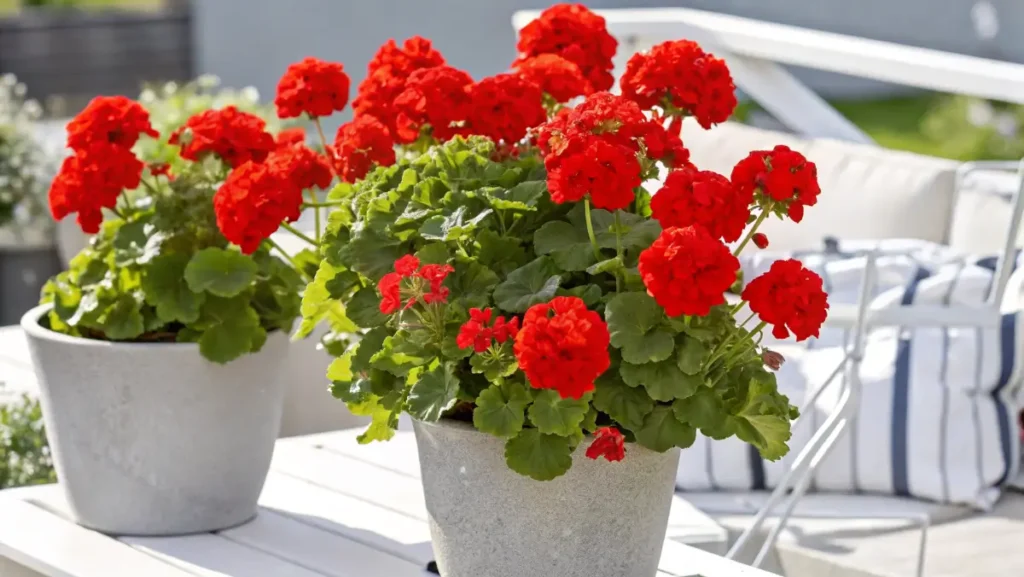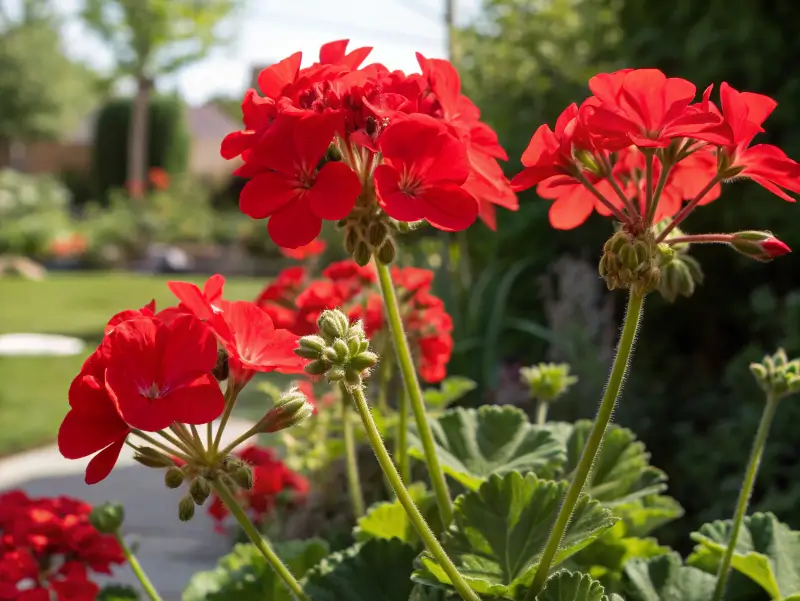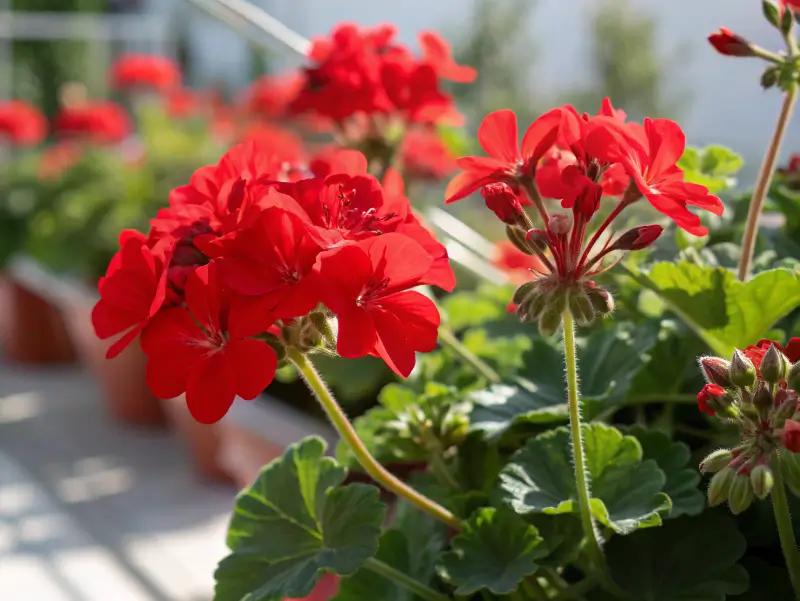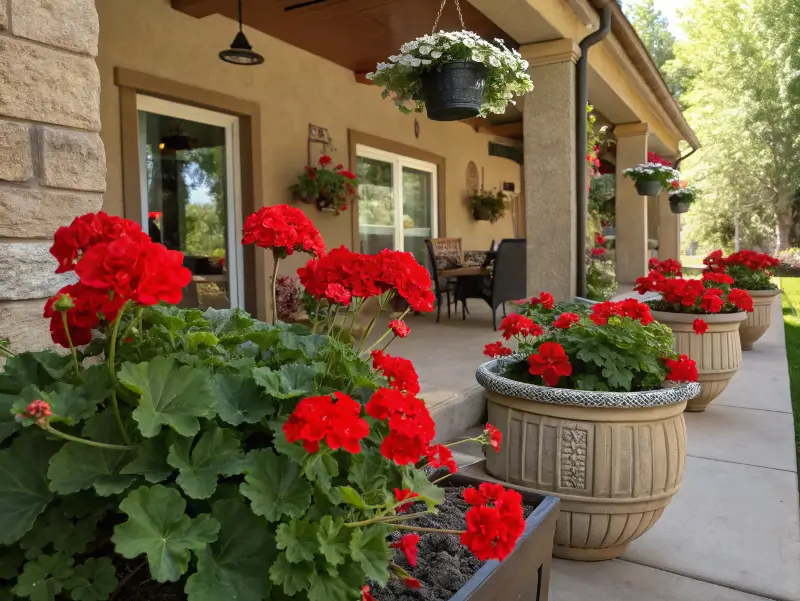
I’m so thrilled you stopped by! Today, I’m sharing my love for red geraniums—one of my favorite garden pals. These bright flowers bring easy color from spring to early fall, and they’re a hot topic right now among plant fans. In this short guide, I’ll share basic care, fun varieties, surprising symbolism, plus simple tips for spacing and pest control. Ready to have your red geranium totally thrive? Let’s go!
Table of Contents
Introduction to red geraniums
Why Choose red geraniums for Your Garden?
I’ve often wondered why these particular blossoms stand out in a sea of colorful plants. Well, red geraniums strike me as:
- Easy to manage (no fuss, no drama).
- Showy, with vivid red petals that demand attention.
- Resilient, even if you sometimes miss a watering day.
I love how red geraniums, sometimes referred to as Pelargoniums, can transform an average yard into a bright retreat. Because gardening hype changes with the seasons, I see more folks combining red geranium with other easy-care flowers. Right now, many of us treat them as warm-season annuals in North America, planting them as soon as the threat of frost passes.
A Quick History of Scarlet Geraniums
I might not be a history buff, but I love fun plant trivia. Legend has it that geraniums originated in South Africa and later traveled to Europe and beyond. Over time, red geranium became a staple in American flower beds, partly because they match patriotic décor (think Memorial Day or Fourth of July). Families also used them as “pass-along” plants, sharing cuttings with friends. Indeed, these well-traveled blooms found a permanent spot in the hearts of many gardeners.
Understanding Red Geranium Botany
Basic Structure and Growth Patterns
When I first started with red geraniums, I wanted to know what makes them tick. Let’s keep it simple:
- Thick, somewhat succulent stems that hold water.
- Circular or slightly scalloped leaves, sometimes with darker rings.
- A cluster of bright red flowers that bloom in umbels, appearing in bunches on top of sturdy stalks.
Because red geraniums are sun-loving annuals (in cooler climates), they thrive under at least six hours of direct sunlight. The leaves often develop interesting patterns, which make them attractive even when the flowers rest. If you look closely, you might see subtle fuzz on the stems—this can help the plant hold moisture, something that sets it slightly apart from thirstier species like hydrangeas.
The Role of Sunlight in Pelargonium Development
Sunlight does more than keep red geraniums from looking droopy. It also helps them produce energy for strong growth. I’ve found that when I place red geranium in partial shade, they sometimes get leggy, stretching out toward the sun. That’s why I aim for a spot where they’ll soak up plenty of rays. If you live in a sizzling area, a bit of afternoon shade can help them avoid wilting. Too much intense sun can scorch the leaves, yet the right balance makes them flourish.
Exploring Different Varieties of red geraniums
Zonal vs. Ivy red geraniums
Zonal red geraniums are probably the ones you see most often. They have that signature band or zone across the leaves. Key perks:
- Thick stems and upright growth.
- Dense clusters of flowers that last a good while.
- Perfect for flower bed arrangements or container gardening ideas.
Ivy red geraniums, meanwhile, have a trailing habit. They’re awesome for hanging baskets or window boxes because they spill gracefully over the edges. Sometimes, folks mix ivy geranium varieties with other trailing plants to create a layered look.
Popular Cultivars and Their Unique Traits
- Bullseye Red: Known for a dark zone in the leaf center, providing a cool contrast to the bright blooms.

- Americana Red: A traditional choice with large, bold flowers.

- Quantum Red: Brings a unique shade of red that leans slightly deeper, giving beds a dramatic vibe.

Each type can fit different aesthetic goals. If you need something tidy and upright, zonal geraniums are your jam. If you want a spill-over effect, ivy geraniums might be the ticket. Personally, I have a soft spot for Bullseye Red. I like the dramatic leaf pattern, which makes my planters feel fancy.
Planting red geraniums—Soil, Spacing, and More
Best Soil Mix for Healthy Geranium Blooms
When planting red geraniums, soil is a big deal. I’ve had great success with a well-draining potting mix. Think about:
- Adding perlite to improve drainage.
- Mixing compost in to boost nutrients.
- Aiming for a pH of around 6.0 to 7.0.
If you’re using garden soil, just make sure you don’t trap excess moisture. Red geranium dislike soggy feet. In my early gardening days, I drowned a couple plants by accident. Let’s face it, overwatering is easy to do.
Seasonal Timing and Proper Spacing
Once the final frost of spring has said goodbye, it’s time to pop your red geraniums into the ground or containers. I usually space them:
- 8 to 12 inches apart for smaller varieties.
- Possibly 12 to 18 inches for bigger hybrids.
Good airflow helps prevent fungal issues. Plus, if you tightly cram red geranium they can fight for nutrients and water, which reduces bloom power. I used to push them too close, and let me tell you, I ended up with spindly growth and fewer flowers. Now, I give them breathing room so they can shine.
Caring for red geraniums—Water, Fertilizer, and Maintenance
Effective Watering Schedules for Vigorous Growth
Water can make or break your red geraniums. I aim to water them two or three times a week in hot weather. However, I do the “finger test”:
- Stick my finger into the soil.
- If it’s dry up to my first knuckle, time to water.
- If it’s still moist, I wait another day.
By following this approach, I rarely overwater. Keep in mind that container plants dry out faster than in-ground ones. If that’s your case, they might need more frequent drinks.
Fertilizing red geraniums for Eye-Catching Color
Red geraniums burn through nutrients, especially when they’re blooming like crazy. I feed them every two weeks with a balanced fertilizer (like 10-10-10). However, I protect them from fertilizer burn by watering first before I feed. Some folks rotate organic products, like well-composted manure or fish emulsion, to keep their flowers happy. If you’re big on organic fertilizers, you could try a gentle approach—just avoid chemical overload.
Pruning and Deadheading Tips
When I see faded blooms, I pinch them off to spark new flowers. This simple trick—called deadheading—prevents the plant from sending energy to spent blossoms. Additionally, I remove dead leaves or any yellowing material as soon as I spot it. It’s easy:
- Use clean, sharp scissors or pruners.
- Snip at the stem’s base.
- Give them a light shape-up if they look leggy.
A tidy geranium is a blooming geranium, in my experience.By the way, if you adore other dramatic blooms, check out Black Dahlia Flower. I planted those near my red geranium once, and the color combo was insane.
Common Pests and Diseases Affecting red geraniums
Identifying and Managing Typical Geranium Pests
I’ve had my share of battles with aphids, spider mites, and even whiteflies on red geraniums. These creepy crawlies can:
- Cause yellowing leaves.
- Spread quickly from plant to plant.
- Make your blooms look sad and damaged.
I typically reach for insecticidal soap or neem oil at the first sign of trouble. A strong blast of water from the hose can also knock some pests off leaves. If you see webbing underneath the foliage, that likely means spider mites. Tackle them early before they get out of control.
Prevention and Treatment of Common Diseases
Fungal troubles like botrytis or powdery mildew often show up if there’s too much humidity and not enough airflow. Meanwhile, root rot can happen if you overwater. For best results:
- Space plants well for ventilation.
- Let the topsoil dry before each watering.
- Remove infected leaves or stems quickly.
If you notice a big problem, consider checking a reliable resource like the U.S. Department of Agriculture for basic plant health tips. Sometimes it’s as simple as improving drainage or giving the plants more sunlight. By making small changes, I usually see a huge difference in my red geranium.
Landscaping with red geraniums
Using Bright Geraniums in Garden Design

Color is everything when you’re planning a garden. I love how red geraniums pop against neutral shrubs or evergreen hedges. They’re also a fun contrast to white or pastel flowers, creating a lively display. Additionally, red geraniums look amazing near walkways:
- They guide the eye and draw guests into the yard.
- They pair well with ornamental grasses or small boxwood hedges.
- They can act as focal points in raised beds.
If you like container gardening ideas, place them in chic pots around patios or deck railings so they’re easy to admire. The bright red really stands out in well-lit locations.
Indoor and Outdoor Décor Ideas
If you’re short on yard space, bring red geraniums into your life by setting them on a sunny windowsill or in a sunroom. I’ve seen folks put them in vintage crates for a rustic vibe. Meanwhile, if you’re hosting a summer barbecue, you can arrange potted geraniums around your seating area. This little touch says, “Welcome, we’re here to party!” The best part is that red geranium handle moderate temperature changes pretty well, so you can shuffle them around if storms roll in.
Symbolism and Cultural Significance of red geraniums
What Do red geraniums Symbolize Around the World?
People have attached color-based meanings to flowers for ages. With red geraniums, that typically translates to:
- Affection or friendship.
- Courage and determination.
- Warmth, especially in a household setting.
Because they’re so bright, red geraniums are often used in patriotic décor during holidays like the Fourth of July. I sometimes see them at community fairs, adding a colorful statement while supporting local pride.
Traditional Uses and Festive Occasions
Back in the day, some cultures believed geranium leaves had mild medicinal uses. Although I wouldn’t rely on them for modern cures, it’s neat to note the lore. You might also find red geranium featured at:
- Housewarming parties, given as a sign of good luck.
- Weddings, for couples who want a bright color that represents pure passion.
- Summer events, acting as cheerful centerpieces or accents in table arrangements.
I’ve even seen them on parade floats—especially if the event has a smaller budget but needs a lot of color. Because red geraniums are readily available at local nurseries, it’s easy to get a bunch in short notice. I love how they stand for both fun times and hardiness.
FAQs About red geraniums
Do red geraniums Like Sun or Shade?
In my opinion, red geraniums adore sun more than shade. They need six or so hours of direct light every day to produce radiant blooms. However, if you live in a scorching area, partial afternoon shade might protect them from leaf scorch. I’ve tried full shade before, and my plants ended up leggy and pale, so trust me—sun is their friend.
Do red geraniums Come Back Every Year?
This depends on your climate. In frost-free regions, red geranium can behave as perennials. However, in colder places, people usually treat them as annuals. If you’re attached to a particular geranium, you can overwinter it indoors by cutting it back and placing it in a sunny window. Water less often, and you might see fresh growth when spring arrives again.
What Do red geraniums Symbolize?
As mentioned, red geraniums often represent friendship, energy, and warmth. Because their color is so bold, they also bring a sense of celebration. I’ve gifted potted geraniums to new neighbors as a way of saying, “Here’s some happiness for your home.”
What Is the Best red geranium?
“Best” is subjective, but here’s what I think:
- Bullseye Red for fancy leaf markings.
- Americana Red for classic style.
- Quantum Red for a deeper scarlet punch.
Experiment with a few to see which style suits your garden.
Conclusion and Final Thoughts
I hope you feel more confident about red geraniums. They’re colorful, dependable, and pretty low-maintenance. Whether you’re new to gardening or an old hand, these blooms can add extra spark to beds, containers, or porch displays in the spring and summer. By giving them proper sunlight, a steady watering routine, and occasional fertilizer, you’ll find it easy to keep them looking sharp. Next time you’re at the garden center, consider picking up some red geranium for that instant pop of color. Trust me, you won’t regret it—these bright beauties are sure to make your home feel more inviting.

5 thoughts on “Red Geraniums: The Complete Growing and Care Tips”
Comments are closed.